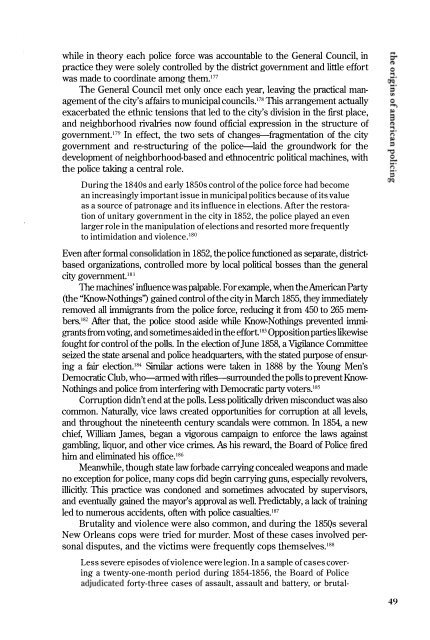Kristian Williams - Our Enemies in Blue - Police and Power in America
Kristian Williams - Our Enemies in Blue - Police and Power in America
Kristian Williams - Our Enemies in Blue - Police and Power in America
You also want an ePaper? Increase the reach of your titles
YUMPU automatically turns print PDFs into web optimized ePapers that Google loves.
while <strong>in</strong> theory each police force was accountable to the General Council, <strong>in</strong>practice they were solely controlled by the district government <strong>and</strong> little effortwas made to coord<strong>in</strong>ate among them. 177The General Council met only once each year, leav<strong>in</strong>g the practical managementof the city's affairs to municipal councils. 178 This arrangement actuallyexacerbated the ethnic tensions that led to the city's division <strong>in</strong> the first place,<strong>and</strong> neighborhood rivalries now found official expression <strong>in</strong> the structure ofgovernment.179 In effect, the two sets of changes-fragmentation of the citygovernment <strong>and</strong> re-structur<strong>in</strong>g of the police-laid the groundwork for thedevelopment of neighborhood-based <strong>and</strong> ethnocentric political mach<strong>in</strong>es, withthe police tak<strong>in</strong>g a central role.Dur<strong>in</strong>g the 1840s <strong>and</strong> early 1850s control of the police force had becomean <strong>in</strong>creas<strong>in</strong>gly important issue <strong>in</strong> municipal politics because of its valueas a source of patronage <strong>and</strong> its <strong>in</strong>fluence <strong>in</strong> elections. After the restorationof unitary government <strong>in</strong> the city <strong>in</strong> 1852, the police played an evenlarger role <strong>in</strong> the manipulation of elections <strong>and</strong> resorted more frequentlyto <strong>in</strong>timidation <strong>and</strong> violence. ISOEven after formal consolidation <strong>in</strong> 1852, the police functioned as separate, districtbasedorganizations, controlled more by local political bosses than the generalcity government. 1 81The mach<strong>in</strong>es' <strong>in</strong>fluence was palpable. For example, when the <strong>America</strong>n Party(the "Know-Noth<strong>in</strong>gs") ga<strong>in</strong>ed control of the city <strong>in</strong> March 1855, they immediatelyremoved all immigrants from the police force, reduc<strong>in</strong>g it from 450 to 265 members.182After that, the police stood aside while Know-Noth<strong>in</strong>gs prevented immigrantsfrom vot<strong>in</strong>g, <strong>and</strong> sometimes aided <strong>in</strong> the effort 183 Opposition parties likewisefought for control of the poils. In the election of June 1858, a Vigilance Committeeseized the state arsenal <strong>and</strong> police headquarters, with the stated purpose of ensur<strong>in</strong>g a fair election.184 Similar actions were taken <strong>in</strong> 1888 by the Young Men'sDemocratic Club, who-armed with rifles-surrounded the polls to prevent KnowNoth<strong>in</strong>gs <strong>and</strong> police from <strong>in</strong>terfer<strong>in</strong>g with Democratic partyvoters.185Corruption didn't end at the polls. Less politically driven misconduct was alsocommon. Naturally, vice laws created opportunities for corruption at all levels,<strong>and</strong> throughout the n<strong>in</strong>eteenth century sc<strong>and</strong>als were common. In 1854, a newchief, William James, began a vigorous campaign to enforce the laws aga<strong>in</strong>stgambl<strong>in</strong>g, liquor, <strong>and</strong> other vice crimes. As his reward, the Board of <strong>Police</strong> firedhim <strong>and</strong> elim<strong>in</strong>ated his office.186Meanwhile, though state law forbade carry<strong>in</strong>g concealed weapons <strong>and</strong> madeno exception for police, many cops did beg<strong>in</strong> carr y<strong>in</strong>g guns, especially revolvers,illicitly. This practice was condoned <strong>and</strong> sometimes advocated by supervisors,<strong>and</strong> eventually ga<strong>in</strong>ed the mayor's approval as well. Predictably, a lack of tra<strong>in</strong><strong>in</strong>gled to numerous accidents, often with police casualties.187Brutality <strong>and</strong> violence were also common, <strong>and</strong> dur<strong>in</strong>g the 1850s severalNew Orleans cops were tried for murder. Most of these cases <strong>in</strong>volved personaldisputes, <strong>and</strong> the victims were frequently cops themselves.188Less severe episodes of violence were legion. In a sample of cases cover<strong>in</strong>ga twenty-one-month period dur<strong>in</strong>g 1854-1856, the Board of <strong>Police</strong>adjudicated forty-three cases of assault, assault <strong>and</strong> battery, or brutal-49


